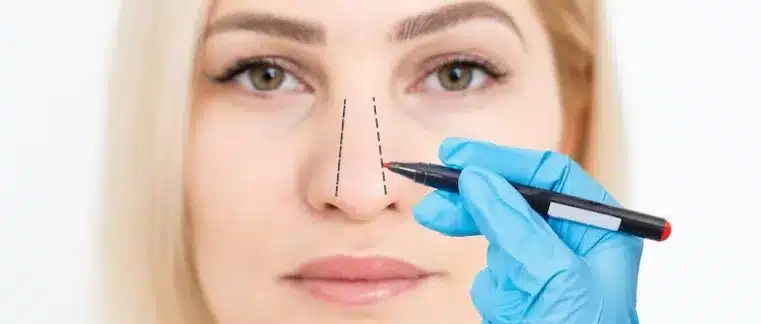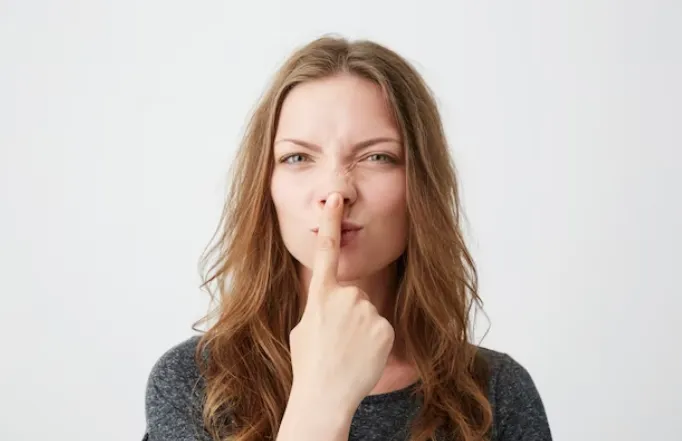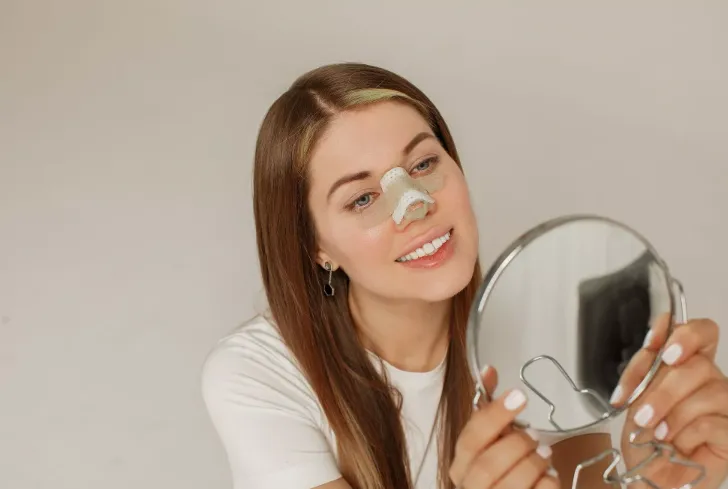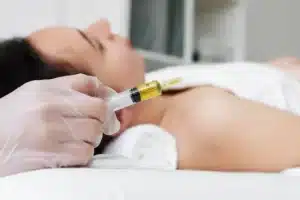Nose job aftercare is a pivotal aspect of post-operative management, drawing upon insights from academic research to optimize patient satisfaction and mitigate complication rates. With a focus on evidence-based practices, tailored aftercare protocols aim to ensure smooth recoveries and favorable surgical outcomes following rhinoplasty procedures. By integrating findings from scholarly studies, surgeons can refine aftercare strategies to better meet patient needs and enhance overall satisfaction while minimizing the risk of post-operative complications.
Step-by-Step Nose Job Process
While the surgical procedure is vital, what follows post-surgery is equally essential for achieving the desired results. This is where “nose job aftercare” steps into the spotlight. A meticulous aftercare routine is pivotal in ensuring a smooth recovery, minimizing discomfort, and maximizing the outcome of your rhinoplasty.
Undergoing a nose job, or rhinoplasty, is a transformative journey that can enhance both appearance and confidence. The process requires careful consideration and planning, whether you’re seeking to address breathing issues or refine your nasal aesthetics.
A fleshy nose is characterized by excess soft tissue, particularly in the nasal tip. It often appears round or bulbous, lacking the defined contours that many desire. Rhinoplasty for fleshy noses focuses on refining the nasal tip, reducing excess cartilage, and reshaping the nose to achieve a more balanced appearance. Surgeons employ cartilage reshaping, tip refinement, and sometimes even nostril reduction to create a refined, natural-looking nose that harmonizes with the overall facial aesthetics.
The nose job procedure involves intricate steps designed to reshape the nose to your desired specifications. Generally performed under general anesthesia, a typical nose job process includes the following:
Consultation
The first step is to schedule a consultation with a board-certified plastic surgeon who specializes in rhinoplasty. During this consultation, you’ll discuss your goals and expectations for the surgery. The surgeon will evaluate your nasal structure, skin thickness, and overall facial anatomy to determine if you’re a suitable candidate for the procedure.
Medical Evaluation
Before scheduling the surgery, your surgeon may request a medical evaluation to ensure you’re in good overall health and don’t have any conditions that could interfere with the surgery or recovery process.
Pre-operative Instructions
Once you’re cleared for surgery, your surgeon will provide you with pre-operative instructions. These may include guidelines for medications to avoid, dietary restrictions, and steps to prepare for the surgery.
Surgery
The surgeon will make incisions either inside the nostrils (closed rhinoplasty) or across the columella (the strip of tissue between the nostrils) in an open rhinoplasty. Through these incisions, they will reshape the nasal bones and cartilage to achieve the desired aesthetic outcome. This may involve reducing or augmenting the nasal structure, refining the tip, or addressing any asymmetries.
Preparation
Once you’re in the operating room, the surgical team will prep you for the procedure. This involves placing monitors to track your vital signs, starting an intravenous (IV) line for fluids and medication administration, and positioning you comfortably on the operating table.
Anesthesia
Before the surgery begins, the anesthesia team will administer the chosen type of anesthesia. If you’re having general anesthesia, you’ll be asleep throughout the procedure. If you’re having local anesthesia with sedation, you’ll be relaxed but awake.
Incisions
The surgeon will make incisions according to the chosen technique—either inside the nostrils (closed rhinoplasty) or across the columella (open rhinoplasty). In closed rhinoplasty, all incisions are made inside the nose, leaving no visible external scars. In open rhinoplasty, an additional incision is made across the columella, allowing the surgeon better access to the nasal structures.
Closing Incisions
Once the desired changes are made, the surgeon will close the incisions with sutures. If necessary, nasal packing or splints may be placed inside the nose to support the new shape and facilitate healing.
Recovery
After the surgery, you’ll be monitored in the recovery area until you’re fully awake and stable. You’ll likely experience some swelling, bruising, and discomfort, which can be managed with pain medication and cold compresses. It’s essential to follow your surgeon’s post-operative instructions carefully to promote proper healing and reduce the risk of complications.
Follow-up Appointments
Your surgeon will schedule follow-up appointments to monitor your progress, remove any packing or splints, and assess the results of the surgery. It’s crucial to attend these appointments and communicate any concerns or questions you may have during the recovery process.
Clinic contact number: +989371200167

Importance of Nose Job Aftercare
Nose job aftercare is a crucial phase that significantly impacts the success of your rhinoplasty. Proper aftercare promotes speedy recovery and reduces the risk of complications, infection, and unsatisfactory results. Here are 15 essential nose job aftercare practices:
Cosmetic surgery offers transformative options for individuals seeking aesthetic enhancements, including procedures like nose job and nose lift. These interventions, encompassing nasal reshaping and reconstruction, address both cosmetic concerns and functional issues such as septoplasty, which improves breathing by correcting nasal septum deviations. Whether for refining nasal appearance or enhancing breathing functionality, these procedures offer personalized solutions tailored to individual needs.
- Rest: Allow ample rest and recover for at least 2 weeks.
- Elevate: Keep your head elevated to minimize swelling.
- Cold Compress: Apply cold compresses to reduce swelling and discomfort.
- Prescribed Medications: Take prescribed medications as directed by your surgeon.
- Avoid Strenuous Activities: Refrain from strenuous exercises or activities that strain your nasal area.
- Hydration: Stay hydrated to promote healing.
- Healthy Diet: Consume a balanced diet rich in nutrients to aid recovery.
- Nasal Hygiene: Follow your surgeon’s instructions for cleaning the incision sites.
- Avoid Smoking: Smoking can hinder healing, so avoid it during recovery.
- Avoid Alcohol: Alcohol consumption can exacerbate swelling and hinder recovery.
- Avoid Sun Exposure: Protect your nose from excessive sun exposure.
- Follow-up Appointments: Attend all post-operative appointments with your surgeon.
- Be Patient: Results take time; don’t rush the healing process.
Consequences of Neglecting Nose Job Aftercare
Neglecting proper nose job aftercare can lead to a range of undesirable outcomes. Failure to follow aftercare instructions can prolong recovery time, increase the risk of infection, cause excessive scarring, and even compromise the final aesthetic results.

Some swelling, particularly over the tip of your nose, can take 12-18 months to completely subside and heal, so it’s important to bear this in mind if you’re still seeing some localised swelling. Julian Rowe Jones
Risks of Avoiding Nose Job Aftercare
- Infection: Improper care can lead to infection at incision sites.
- Increased Swelling: Neglecting aftercare may result in prolonged swelling.
- Delayed Healing: Poor aftercare can slow down the healing process.
- Unsatisfactory Results: Skipping aftercare instructions might lead to less-than-desired outcomes.
- Excessive Scarring: Inadequate care could result in noticeable scars.
- Complications: Neglecting aftercare may lead to severe complications.
- Persistent Discomfort: Discomfort might linger if aftercare is ignored.
- Bleeding: Failure to follow guidelines can cause post-operative bleeding.
- Nasal Deformities: Skipping aftercare may contribute to irregularities in the nasal structure.
- Revision Surgery: Poor results may necessitate additional corrective procedures.
Clinic contact number: +989371200167
HOW LONG IS RECOVERY FROM RHINOPLASTY
Recovery from rhinoplasty, commonly known as a nose job, varies from person to person and depends on several factors, including the extent of the procedure, individual healing abilities, and adherence to post-operative care instructions. In general, most patients can expect the initial phase of recovery to last approximately one to two weeks. During this time, swelling, bruising, and discomfort around the nasal area are common.
Patients may also experience congestion, nasal stuffiness, and difficulty breathing through the nose as the tissues heal. It’s essential to follow post-operative care instructions provided by your surgeon, such as keeping the head elevated, applying cold compresses to reduce swelling, and taking prescribed medications to manage pain and prevent infection.
Welcome to the realm of non-surgical nose jobs, where transformative enhancements are achieved through the artful application of dermal fillers. This innovative approach to nasal augmentation offers a non-invasive alternative to traditional rhinoplasty, utilizing injectable techniques to sculpt and refine the contours of the nose. With injectable rhinoplasty, individuals can achieve subtle yet significant changes in nasal appearance without the need for surgery, heralding a new era in cosmetic procedures.
As the initial swelling subsides, patients typically notice gradual improvements in nasal appearance and breathing function over the following weeks and months. By the end of the first month, the majority of visible swelling and bruising should resolve, allowing patients to return to normal daily activities with caution. However, it’s essential to avoid strenuous activities, heavy lifting, and contact sports for several weeks to minimize the risk of complications and ensure optimal healing. While most patients are satisfied with the initial results of rhinoplasty within the first few months, it can take up to a year or longer for the final results to fully manifest as the nasal tissues settle into their new shape and contour.
Throughout the recovery process, attending follow-up appointments with your surgeon is essential for monitoring progress, addressing any concerns or complications promptly, and ensuring that healing is progressing as expected. Your surgeon can provide personalized guidance on when it’s safe to resume specific activities and offer recommendations for long-term nasal care to maintain the results of rhinoplasty. By following post-operative care instructions diligently and allowing ample time for healing, patients can achieve the best possible outcome from rhinoplasty and enjoy the aesthetic and functional improvements to their nose for years to come.

8 Things to Avoid After a nose job
There are specific actions and habits you should avoid after a nose job (rhinoplasty). Here are 8 things you should steer clear of:
1. Strenuous Activities: Engaging in strenuous physical activities such as heavy lifting, intense workouts, and vigorous exercise can lead to increased blood flow and elevated blood pressure, which might impede the healing process and contribute to post-operative complications.
2. Touching or Picking the Nose: Resist the urge to touch, scratch, or pick at your nose after rhinoplasty. Doing so can disrupt the healing incisions, introduce bacteria, and potentially lead to infection.
3. Wearing Glasses: Avoid wearing glasses that rest on the bridge of your nose for a few weeks following the surgery. The pressure from glasses can impact the healing nasal structure and lead to unwanted changes.
4. Sun Exposure: Direct sun exposure can cause swelling and exacerbate bruising after surgery. Protect your nose from the sun’s rays by wearing a wide-brimmed hat and applying sunscreen as your surgeon recommends.
5. Smoking: Smoking can hinder healing by reducing blood flow to the surgical site and increasing the risk of complications. If possible, it’s best to quit smoking before and after rhinoplasty.
6. Alcohol Consumption: Alcohol consumption can contribute to swelling and disrupt healing. It’s advisable to abstain from alcohol during the initial stages of recovery.
7. Nasal Irritants: Avoid exposure to dust, smoke, and strong odors, as these can irritate the healing nasal passages and potentially lead to complications.
8. Skipping Follow-Up Appointments: Regular follow-up appointments with your surgeon are crucial for monitoring your progress and addressing concerns. Skipping these appointments could result in delayed detection of potential issues.

By steering clear of these eight activities and adhering to your surgeon’s post-operative instructions, you can contribute to a smooth and successful recovery after rhinoplasty. Remember that taking proper care of yourself during the healing process is an investment in the long-term outcome of your procedure.
Clinic contact number: +989371200167
painful nose job
Katie Price has given fans a new health update after going under the knife once again for a painful nose job operation. The glamour model, 45, took to her TikTok page to tell all about her latest surgery as she appeared live wearing a large bandage on her nose. The former I’m A Celebrity star began her live session by trawling in her wardrobe and shifting some of her clothes – but eventually opened up about the aftercare of her operation.
Katie, who flaunted her very ample cleavage in a black tank, admitted that her nose was very ‘sore’ after undergoing another surgery in Berlin recently. ‘My nose is all swollen!’ she complained as she touched the hefty bandage on her nose. ‘My nose is sore. I’m having stitches out today, but the cast has to stay on for two weeks. ‘It’s really sore, and you’re not allowed to blow your nose or wash it,’ Katie explained. Despite the obvious pain the glamour model was in, it appears this won’t be her last time going under the knife.
A source told The Sun that Katie has planned to undergo more cosmetic surgery soon. ‘Katie will be going to Belgium next week for a nose job, lip lift and abdominal etching. ‘She’s done all the proper checks on the clinic. It’s not too far away from home and Katie feels she’ll be in safe hands. The telly source added: ‘It will be corrective surgery to fix some previously botched operations. Katie can’t wait to be summer ready.’ Although Katie’s mum, Amy, seemed to be of a different opinion when it comes to her cosmetic surgery procedure, as she recently claimed her daughter has body dysmorphia.
Latest Research and Clinical Perspectives
Nose job aftercare, a critical phase in the rhinoplasty journey, has seen significant advancements in recent years, propelled by research from institutions such as Johns Hopkins University and the University of California, Los Angeles (UCLA). Renowned pioneers like Dr. Rod J. Rohrich, a leading figure in plastic surgery, have contributed seminal work in the development of post-operative protocols. Amidst this landscape, companies like Mayo Clinic and Cleveland Clinic have emerged as leading providers of comprehensive aftercare services, integrating innovative technologies and evidence-based practices.
Recent statistics highlight the importance of meticulous post-operative management, with studies indicating a notable reduction in complication rates and improved patient satisfaction through optimized aftercare regimens. According to data from the American Society of Plastic Surgeons, the demand for rhinoplasty procedures continues to rise steadily, with over 207,000 surgeries performed in 2022 alone. Such figures underscore the growing need for specialized aftercare interventions tailored to individual patient needs, emphasizing the role of multidisciplinary teams in ensuring favorable outcomes and long-term patient well-being.

Summary
Nose job aftercare is a pivotal aspect of post-operative management, drawing upon insights from academic research to optimize patient satisfaction and mitigate complication rates. With a focus on evidence-based practices, tailored aftercare protocols aim to ensure smooth recoveries and favorable surgical outcomes following rhinoplasty procedures. By integrating findings from scholarly studies, surgeons can refine aftercare strategies to better meet patient needs and enhance overall satisfaction while minimizing the risk of post-operative complications.
FAQs
1. Why is aftercare important following a nose job (rhinoplasty)?
– Aftercare is crucial following a nose job to support optimal healing, minimize the risk of complications, and achieve the best possible results. Rhinoplasty is a surgical procedure that involves reshaping the nasal structure, and the body needs time to recover and adapt to the changes. Proper aftercare, including following post-operative instructions provided by your surgeon, can help reduce swelling, bruising, and discomfort, promote tissue healing, and ensure long-lasting, satisfactory outcomes.
2. What are some essential components of nose job aftercare?
– Essential components of nose job aftercare typically include keeping the head elevated, applying cold compresses or ice packs to reduce swelling, taking prescribed medications as directed (such as pain relievers and antibiotics), avoiding strenuous activities or heavy lifting, and attending follow-up appointments with your surgeon. It’s also important to refrain from blowing your nose forcefully, wearing glasses or sunglasses that rest on the bridge of the nose, and exposing the nose to excessive sun or heat during the initial stages of recovery to prevent complications and optimize healing.
3. How long does nose job aftercare last?
– Nose job aftercare typically lasts for several weeks to months, depending on the extent of the procedure and individual healing factors. While most patients experience significant improvement in swelling and bruising within the first few weeks after rhinoplasty, it can take several months for the nasal tissues to fully settle into their new shape and for the final results to become apparent. Following your surgeon’s aftercare instructions diligently throughout the entire recovery period is essential for ensuring the best possible outcome from your nose job.
4. What are the consequences of neglecting nose job aftercare?
– Neglecting nose job aftercare can lead to complications such as prolonged swelling, increased risk of infection, delayed healing, and suboptimal aesthetic results. Failure to follow post-operative instructions, such as engaging in strenuous activities too soon or not taking prescribed medications as directed, can hinder the healing process and potentially compromise the outcome of the rhinoplasty. It’s important to prioritize self-care and adhere to your surgeon’s recommendations to minimize the risk of complications and achieve the desired aesthetic improvements to the nose.
5. When can I resume my regular exercise after a nose job?
It’s typically recommended to avoid strenuous activities for at least a few weeks after surgery to prevent strain on your healing nasal area.
6. Can I wear glasses after a nose job?
Your surgeon will advise you when it’s safe to start wearing glasses again, as they can pressure the healing nasal structure.
A Guide to Nose Job Aftercare | The Nose Clinic
https://www.dailymail.co.uk/tvshowbiz/katie-price/article-12303703/Katie-Price-gives-fans-health-update-going-knife-painful-nose-job.html



